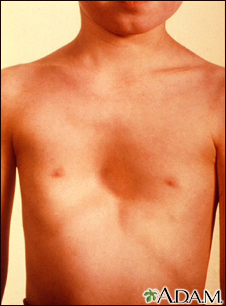Pregnancy SmartSiteTM
Funnel chest repair; Chest deformity repair; Sunken chest repair; Cobbler's chest repair; Nuss repair; Ravitch repair DefinitionPectus excavatum repair is surgery to correct pectus excavatum. This is a congenital (present at birth) deformity of the front of the chest wall that causes a sunken breastbone (sternum) and ribs. Pectus excavatum is also called funnel or sunken chest. It may worsen during the teen years. DescriptionThere are two types of surgery to repair this condition -- open surgery and closed (minimally invasive) surgery. Either surgery is done while the child is in a deep sleep and pain-free from general anesthesia. Open surgery is more traditional. The surgery is done the following way:
The second type of surgery is a closed method. It is used mostly for children. No cartilage or bone is removed. The surgery is done the following way:
Surgery may take 1 to 4 hours, depending on the procedure. Why the Procedure Is PerformedThe most common reason for pectus excavatum repair is to improve the appearance of the chest wall. Sometimes the deformity is so severe that it causes chest pain and limits breathing, largely in adults. Surgery is mostly done on children who are 12 to 16 years old, but not before age 6. It can also be done on adults in their early 20s. RisksRisks for anesthesia and surgery in general are:
Risks for this surgery are:
Before the ProcedureA complete medical exam and medical tests are needed before the surgery. The surgeon will order the following:
Tell the surgeon or nurse about:
During the days before the surgery:
On the day of surgery:
After the ProcedureIt is common for children to stay in the hospital for 3 to 7 days. How long your child stays depends on how well the recovery is going. Pain is common after the surgery. For the first few days, your child may receive strong pain medicine in the vein (through an IV) or through a catheter placed in the spine (an epidural). After that, pain is usually managed with medicines taken by mouth. Your child may have tubes in the chest around the surgical cuts. These tubes drain extra fluid that collects from the procedure. The tubes will remain in place until they stop draining, usually after a few days. The tubes are then removed. The day after surgery, your child will be encouraged to sit up, take deep breaths, and get out of bed and walk. These activities will help healing. At first, your child will not be able to bend, twist, or roll from side to side. Activities may be slowly increased. When your child can walk without help, they are probably ready to go home. Before leaving the hospital, you will receive a prescription for pain medicine for your child. At home, follow any instructions for caring for your child. Outlook (Prognosis)The surgery usually leads to improvements in appearance, breathing, and ability to exercise. ReferencesDemehri FR, Shamberger RC. Congenital chest wall deformities. In: Selke FW, del Nido PJ, Swanson SJ, eds. Sabiston and Spencer Surgery of the Chest. 10th ed. Philadelphia, PA: Elsevier; 2024:chap 24. Wald O, Izhar U, Sugarbaker DJ. Lung, chest wall, pleura and mediastinum. In: Townsend CM Jr, Beauchamp RD, Evers BM, Mattox KL, eds. Sabiston Textbook of Surgery: The Biological Basis of Modern Surgical Practice. 21st ed. St Louis, MO: Elsevier; 2022:chap 58. | ||
| ||
Review Date: 1/27/2025 Reviewed By: Mary C. Mancini, MD, PhD, Cardiothoracic Surgeon, Shreveport, LA. Review provided by VeriMed Healthcare Network. Also reviewed by David C. Dugdale, MD, Medical Director, Brenda Conaway, Editorial Director, and the A.D.A.M. Editorial team. View References The information provided herein should not be used during any medical emergency or for the diagnosis or treatment of any medical condition. A licensed medical professional should be consulted for diagnosis and treatment of any and all medical conditions. Links to other sites are provided for information only -- they do not constitute endorsements of those other sites. No warranty of any kind, either expressed or implied, is made as to the accuracy, reliability, timeliness, or correctness of any translations made by a third-party service of the information provided herein into any other language. © 1997- A.D.A.M., a business unit of Ebix, Inc. Any duplication or distribution of the information contained herein is strictly prohibited. | ||


 Pectus excavatum
Pectus excavatum
